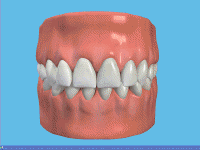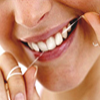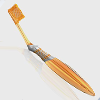
Crowns & Bridges
Crowns are an ideal restoration for teeth that have been broken, or have been weakened by decay or a very large filling. A crown could be used for a number of other reasons, for instance: 1. to improve the appearance of the teeth that are misshaped, poorly positioned or with unsightly fillings, 2. to give structural support to teeth that may have had been root filled or 3. it may be necessary to help hold a bridge or denture firmly in place.
In root-filled teeth it may be necessary to insert a post before placing a crown. A post provides support and helps the crown stay in place. The weakened crown of the tooth may be shortened to gum level. A post can be made of prefabricated stainless steel, glass fibre or carbon fibre depending on the case in which the dentist can fit directly into the root canal, or a custom-made post can be constructed by the dental technician to accurately fit the shape of the prepared root canal. The post is placed into the root canal and cemented in position, ready for the crown to be attached.
If a root-filled tooth is not completely broken down, it may be possible to build it up again using filling material. This 'core' is then prepared in the same way as a natural tooth and the impressions are taken.
Crowns can be made of a variety of different materials and new materials are continually being introduced. Some of the most popular options are listed below.
Porcelain bonded to precious metal: this is what most crowns are made from. A precious metal base is made and then porcelain is applied in layers over it.
All-ceramic crowns: this modern technique offers a metal-free alternative, which can give the strength of a bonded crown and the appearance of a porcelain crown. Therefore it is suitable for use in most areas of the mouth.
Gold crowns: gold is one of the oldest filling materials and to this day is still biomechanically the best material used in the mouth. It is used with other metal alloys to increase its strength, which makes it a very hardwearing restoration. These crowns are gold in colour and today are less utilised as tooth colored solutions are becoming more favourable for aesthetic reasons.
The dentist will prepare the tooth to the ideal shape for the crown. This will involve removing most of the outer surface, and leaving a strong inner core. The amount of the tooth removed will be the same as the thickness of the crown. Once the tooth is shaped, the dentist will take an impression (mould) of the prepared tooth, one of the opposite jaw and possibly another to mark the way you bite together.
The impressions will then be given to the dental technician, along with an appropriate shade and other information needed for the crown to be made.
A temporary crown will be made so that you can use the tooth while you wait for the crown to be made. This crown may be more noticeable but is only a temporary measure.
When we are happy with the fit and appearance of the new crown it will be fixed in place with special dental cement or adhesive. The cement forms a seal to hold the crown in place.
You will need to have at least two visits: the first for the preparation, impression, shade taking and fitting the temporary crown; and the second to fit the permanent crown. There will usually be about 1 to 2 weeks in between appointments.
A local anaesthetic is normally used and the preparation should feel no different from a filling. If the tooth does not have a nerve, and a post crown is being prepared, then a local anaesthetic may not be needed.
The crown will be made to match your other teeth exactly. The shade of the neighbouring teeth will be recorded, to make sure that the colour looks natural and matches the surrounding teeth.
Because the shape of the crown will be slightly different from the shape of your tooth before it was crowned, you may be aware of it to begin with. Within a few days it should feel fine, and you will not notice it. The crown may need some adjustment if your bite does not feel comfortable, so you should ask your dentist to check and adjust it.
How long your crown lasts depends on how well you look after it. The crown itself cannot decay, but decay can start where the edge of the crown joins the tooth. Therefore, it is important to keep this area just as clean as you would your natural teeth and keep the frequency of sugar intake to a minimum to prevent inflammation of the gums and decay affecting the crown.
In what scenarios do I need a crown?
Crowns can be used to improve the appearance of discoloured, filled or misaligned teeth.
Crowns can be used to save a tooth previously filled, or broken beyond repairing it with a filling. Bridges can be used to close a gap in your smile.
Do you have a crown with a black metal edge or is stained?
The solution for you is an all ceramic crown like Procera AllCeram Crown. In long term clinical studies, 7 - 10 years, Procera All Ceram Crowns have been documented and proven to be a successful solution which can be placed in any position in the mouth. Other all ceramic systems include Lava and Empress- your dentist should be able to select the most appropriate solution for you.
Esthetic - The esthetic results that are possible to achieve with Procera AllCeram are remarkable. The optical properties of the densely sintered aluminium oxide core provides an optimal base for the dental technician to complete the porcelain work. It is almost impossible to distinguish a real tooth from the Procera AllCeram restoration.
Reliable - More than 1,500,000 Procera AllCeram restorations have been placed in patients' mouths over the past ten years. Remarkable results have been obtained in controlled clinical studies. Extremely low fracture rates have been reported and the restorations serve for many years.






